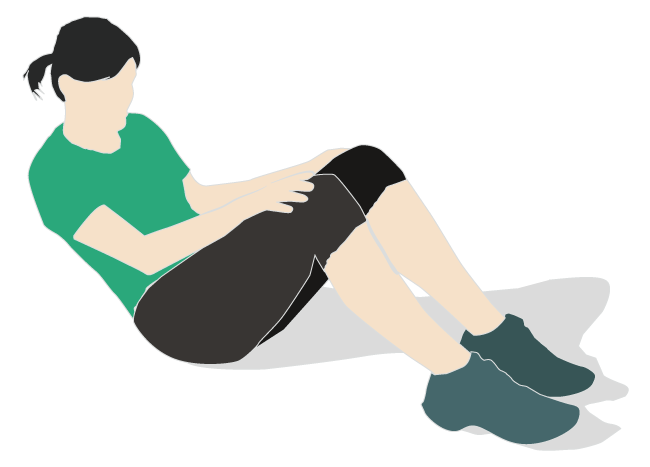The President's Challenge fitness award program has been largely replaced by the FitnessGram Program. As such, the following curl up test has been replaced by the FitnessGram Curl-Up.
There are two variations of the curl-up test which were used in testing for the President's Challenge - the 'curl-up test' and the improved 'partial curl-up'. The partial curl up test is described below, in which the participants perform as many curl-ups as possible at a rate of 1-in-3 seconds. See another page which describes the standard and original President's Challenge Curl-Up Test. There is also a similar Partial Curl Up Test used in the Connecticut Physical Fitness Test.
These tests measure the muscular strength and endurance of the abdominal and hip-flexor muscles. Abdominal muscle strength is important for core stability and back support. See the general guidelines for Abdominal Endurance Tests.
test purpose: The curl-up test measures abdominal strength and endurance, important in back support and core stability.
equipment required: you need a flat, clean, cushioned surface, stopwatch, recording sheets, pen, and a metronome (or audio file, drums). A sit up beep test mp3 with the 1-in-3 sec cadence is also available for purchase. There is also an online sit-up metronome that you can use. The sit-up track on the PACER cd is also at the same cadence.
pre-test: Explain the test procedures to the subject. Perform screening of health risks and obtain informed consent. Prepare forms and record basic information such as age, height, body weight, gender, test conditions. See more details of pre-test procedures.
 the sit up assessment technique
the sit up assessment techniqueprocedure: The feet are not anchored, the partner sits behind the subject and cups the participant's head in their hands. The starting position has the arms fully extended with fingers resting on the legs and pointing toward the knees. The subject curls up slowly, sliding the fingers along the legs until the fingertips touch the knees, then back down again, until the head touches the partner's hands. One complete curl-up is completed every three seconds, and are continued until exhaustion (e.g. the subject cannot maintain the rhythm or has reached the target number for the test). See the similar CT Partial Curl Up Test.
scoring: Record the maximum number of curl-ups performed in at the desired rate. The completion of one complete curl up counts as one. Make sure that the subject does not "bounce" off the floor - only correctly performed curl-ups should be counted.
notes: this test is simple and quick to perform requiring minimal equipment, and large groups may be tested at once. This partial curl up test, in which the feet are not supported, is a better measure of abdominal strength and endurance than tests in which the feet at anchored.
comments: The partner may assist by counting aloud the number of repetitions. It is important that the correct technique is used as described for accurate comparison to the norms. If using a variation of the test procedure or technique, the actual technique and procedure should be recorded with the results, and appropriate norm tables consulted.
guidelines: before conducting any fitness test, you should review each person's medical status to identify medical, orthopedic or other health problems that should be considered. Before starting, make sure the correct techniques for all tests are explained. (see the Fitness Testing Guidelines for more info)
The Test in Action
- This test was part of the President's Challenge fitness award program
Similar Tests
- President's Challenge Curl-Up Test.
- The similar Partial Curl Up Test used in the Connecticut Physical Fitness Test.
- Simple sit-up test that you can do at home
- Sit-up tests procedures for the US Army and US Marines and US Navy
Related Pages
- Purchase the sit-up test audio file
- General Abdominal Endurance Test description.
- About Abdominal Testing
- Online sit-up metronome where you can set your own pace.
- Videos of Sit Up Fitness Tests
- President's Challenge Fitness Awards
- Sit up exercise at the beach or at home
- All fitness tests list
- Sit-Up World Records


 Current Events
Current Events